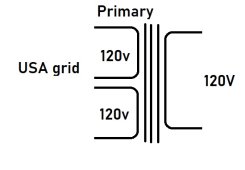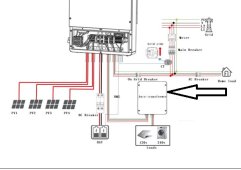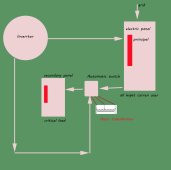I suppose you have a 240v inverter where each leg gives 120v 4Kw, total 8Kw, but you have a device that occasionally consumes 6Kw, if we put this to the device, we would never have a stop due to over current! Who knows where we could find this transformer? if it exists! of course thinking on 8Kw or more
You are using an out of date browser. It may not display this or other websites correctly.
You should upgrade or use an alternative browser.
You should upgrade or use an alternative browser.
Could you adjust load using a transformer with 240V USA standard to 120V? Check below.
- Thread starter adolfo
- Start date
sunshine_eggo
Happy Breffast!
if you put a secondary transformer on the 240V circuit, you could step that down to a little less than 8kW@120V.
Victron makes a 100A Autotransformer.
Victron makes a 100A Autotransformer.
thanks for your fast answers, Is that auto transformer capable of balancing the loads on the legs, transferring power from one to the other? and is it for the grid of usa?if you put a secondary transformer on the 240V circuit, you could step that down to a little less than 8kW@120V.
Victron makes a 100A Autotransformer.
sunshine_eggo
Happy Breffast!
Used in the fashion described it is not using the Neutral on the input, so it by default "balances" the loads on the legs by pulling equally from both legs.
Please read:
Please read:
I read it.only it is a some weird to me... I'm only confirm with you!Used in the fashion described it is not using the Neutral on the input, so it by default "balances" the loads on the legs by pulling equally from both legs.
Please read:
was general the question because my inverter are HV and It come with him auto transformer. and was looking confirmation of my suspected, my doubt arose from the 180 degree de-phase!I originally said I didn't think this would work, but now I'm not sure. I'm reading the doc and it's a bit confusing.
Attachments
Outback has that option. It's called the X240. But it's more to power 240v loads off of twin 120v inverters. Then one 120v inverter can go into sleep mode, and you can still power your 240v loads, up to 1kw. After 1kw, the second inverter turns on and then they share the load.
?Outback has that option. It's called the X240. But it's more to power 240v loads off of twin 120v inverters. Then one 120v inverter can go into sleep mode, and you can still power your 240v loads, up to 1kw. After 1kw, the second inverter turns on and then they share the load.
interesting, could you give me a link to that?
?
interesting, could you give me a link to that?
Thanks, perfect solution... better impossible ( can I use on another inverter? do you know if some one used on other inverter ?)
Last edited:
tigerwillow1
Solar Enthusiast
- Joined
- Sep 20, 2021
- Messages
- 194
Are you talking about a 6 kW device at 120 volts? 50 amps?
120ac at 50A aren't 6Kw... it are close to 10Kw!... but yes, could be 6 or 7Kw!Are you talking about a 6 kW device at 120 volts? 50 amps?
tigerwillow1
Solar Enthusiast
- Joined
- Sep 20, 2021
- Messages
- 194
My math thinks 10 kW at 120 volts is 83 amps, but either way, I've got nothing to offer for a solution. I think there would be more options for that power level at 240 volts.
I have a miscalculation , the auto transformer no need to be 6kw, becaus it add power, example if you have 2 leg of 4K, with one autoT, of 3Kw is enought.... because every leg could be ( separated) 7kw ... 4 basic and 3 tranfer if no one are using!.................................. by the way V*A=W if it are DC, on AC are =V*A*1.7
I have a miscalculation , the auto transformer no need to be 6kw, becaus it add power, example if you have 2 leg of 4K, with one autoT, of 3Kw is enough.... because every leg could be ( separated) 7kw ... 4 basic and 3 transfer if no one are using!.What are you trying to power and what are the ratings of the device voltage and current ?
what do you think about it! ( first is the normal use , seconds pic, ???) the objective is balance too, when the inverter are delivery energy and are on grid!I originally said I didn't think this would work, but now I'm not sure. I'm reading the doc and it's a bit confusing.
Attachments
Keith C
Ahhh, the sharks have him.
A non-auto transformer can take all of the 240V power and convert it to 120V on a single leg.
The way this works is that all the 240V goes into magnetizing the transformer core. At that point the 240V source doesn't care about anything going on with the transformer's secondaries.
At the transformer secondary there is the amount of power available that's been injected by the primary.
You can pull that power out via one winding, two windings, or a dozen as long as you don't pull more than was injected. If you do then all the voltages of the secondary taps will drop.
Furthermore, you must be mindful of the actual secondary wire size. If you exceed the rated current out of one of those secondary taps you will damage the insulation. If you want to feed 240 and 120V loads in a mixed and convenient way you'd want to size the transformer so that either of the 120V windings can output the full power being injected into the primary.
The way this works is that all the 240V goes into magnetizing the transformer core. At that point the 240V source doesn't care about anything going on with the transformer's secondaries.
At the transformer secondary there is the amount of power available that's been injected by the primary.
You can pull that power out via one winding, two windings, or a dozen as long as you don't pull more than was injected. If you do then all the voltages of the secondary taps will drop.
Furthermore, you must be mindful of the actual secondary wire size. If you exceed the rated current out of one of those secondary taps you will damage the insulation. If you want to feed 240 and 120V loads in a mixed and convenient way you'd want to size the transformer so that either of the 120V windings can output the full power being injected into the primary.
Similar threads
- Replies
- 23
- Views
- 767
- Replies
- 3
- Views
- 654
- Replies
- 39
- Views
- 2K
- Replies
- 7
- Views
- 542







